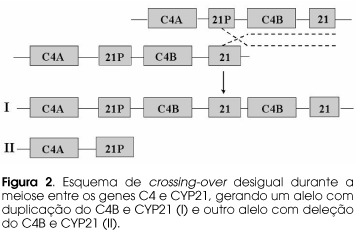Congenital adrenal hiperplasia (CAH) is a recessive autossomic disease caused by inherited defects in cortisol biosynthesis. The manifestations are caused both by the deficient synthesis of cortisol, and sometimes of aldosterone, and by accumulation of the precursor steroids. The objective of this review is to present the molecular mechanisms of the main enzymatic defects involved in the etiopathogenesis of CAH. Deficiency of 21-hydroxylase (21OH) accounts for more than 95% of all cases of CAH. The human genome contains two CYP genes: one active, CYP21, and a pseudogene, CYP21P. Both are highly homologous (98%), facilitating recombination events during meiosis, leading to duplication and/or deletion or conversion of these genes. Additionally, point mutations have also been described. Deficiency of 11beta-hydroxylase (11betaOH) is caused by mutations in the CYP11B1 gene, and accounts for 5% of all cases. Some mutations are recurrent, and mainly located on exons 6-8, which is considered a hot-spot area in CYP11B1 gene. Deficiency of 17alpha-hydroxylase (17OH) is caused by mutations in the CYP17 gene, producing a truncated or impaired protein. These mutations have been described in patients with combined deficiencies of 17OH and 17,20-lyase or with isolated 17,20-lyase. Finally, CAH caused by 3beta-HSD deficiency is the consequence of mutations in the gene HSD3B2 that encodes 3beta-HSD type II. In the classical form of the disease nonsense mutations, insertion and deletions have been described, while in non classical forms, mutations result in diminished enzyme affinity and loss of enzyme activity.
Congenital adrenal hyperplasia; 21-hydroxylase deficiency; 11beta-hydroxylase deficiency; 17-hydroxylase deficiency; 3beta-HSD deficiency











